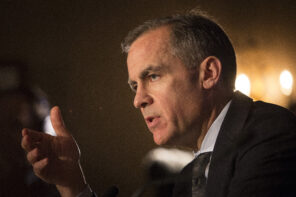As 2025 approaches, the global economy is grappling with inflation, recession, and signs of recovery. This backdrop emphasizes the impact on Canada, historically tied to its largest trading partner, the United States, through one of the world’s most significant trading relationships. This bond, which has fueled mutual economic growth and stability for decades, now faces a new challenge with the recent re-election of President Trump in the United States. His presidential victory signals a probable resurgence of protectionist economic policies which could have profound implications for Canada, particularly from the likelihood of significant tariffs being imposed. These tariffs are poised to reshape trade dynamics between Canada and its largest trading partner, creating a challenging environment for Canadian economic sectors, and significantly affecting the futures of students and young professionals.
This bond, which has fueled mutual economic growth and stability for decades, now faces a new challenge with the recent re-election of President Trump in the United States.
The re-election of President Trump is pivotal as it heralds a return to his earlier protectionist economic policies, most notably his proposal to implement a 10-20% tariff on all imports, with even steeper tariffs on goods from China. This assertive policy threatens to fracture the long-standing trade relations between Canada and the U.S., casting a shadow over Canada’s export-driven economic sectors. For industries like manufacturing, this could mean operational costs would surge as tariffs on imported raw materials and finished products would drive up prices. This increase could disrupt business operations significantly and translate into higher prices for Canadian consumers, potentially altering the economic stability of the nation, affecting everything from production costs to retail prices.
Despite the looming challenges posed by U.S. policy shifts, Canada’s economy has demonstrated resilience, evidenced by a GDP growth of 2.1% in the second quarter of 2024. However, this growth obscures underlying vulnerabilities. The nation’s inflation rate, though currently stable, is buoyed by fluctuating commodity prices, such as the notable 10.7% drop in gasoline prices year-over-year. Yet, this relief is offset by rising costs in other essential living expenses such as rent and food, continually straining household budgets across the country.
The high level of household debt in Canada, which stands at 178.2% of debt-to-income and is expected to rise, poses another significant challenge. Such precarious financial standing is risky in stable times and could be catastrophic should external shocks—like those posed by new U.S. tariffs—disturb the fragile economic balance. With unemployment also on the rise–reflecting a slowdown in the labour market–the broader economic outlook for Canada presents challenges.
A potential trade war sparked by U.S. tariff impositions could have extensive repercussions for Canada’s economy. Industries like manufacturing and agriculture, heavily reliant on U.S. trade relations, could face severe disruptions, such as increased operational costs, price hikes for consumers, and disruptions in supply chains. This scenario requires a strategic response from Canadian policymakers and the Bank of Canada, who may need to consider easing monetary policies further and implementing fiscal measures targeted at supporting vulnerable industries. However, this period of tension could drive innovation within Canadian industries, encouraging a shift towards more sustainable and self-sufficient practices.
Industries like manufacturing and agriculture, heavily reliant on U.S. trade relations, could face severe disruptions, such as increased operational costs, price hikes for consumers, and disruptions in supply chains.
The future of Canada’s job market, particularly for students and young professionals, is increasingly concerning. The highest unemployment rates since 2009 signal severe challenges ahead in securing gainful employment, which could stifle wage growth and career development. Specifically, the unemployment rate for youth aged 15 to 24 reached 14.2% in July 2024, the highest since September 2012. Additionally, the number of job vacancies significantly dropped by 9.2% in the second quarter of the year, indicating a steeper decline than in the previous quarter. 80% of this uptick in unemployment affects those under 35 years old, including students and new graduates struggling to secure their first positions. This trend shows the difficulties many young Canadians face in transitioning from educational settings to professional roles. With students also dealing with rising educational costs and living expenses in an increasingly unstable financial climate, the need for enhanced financial aid, scholarships, and flexible work-study options is more pressing than ever, alongside robust career counselling services designed for the fluctuating job market and changing economic demands.
In response to these economic challenges, Canadian businesses and policymakers are likely to engage in rigorous strategic planning. Companies might look to diversify their markets, seeking alternatives to U.S. dependencies by exploring trade opportunities in emerging markets in Asia and Europe. On the policy front, Canada could strengthen its trade agreements within the Comprehensive and Progressive Agreement for Trans-Pacific Partnership (CPTPP) or seek new agreements with other trading blocs such as the Association of Southeast Asian Nations (ASEAN). This would not only mitigate the risks posed by U.S. protectionism but also open new channels for economic expansion. Moreover, the Canadian government might find it necessary to boost domestic innovation to reduce reliance on imports. Investment in technology and green energy sectors could see an uptick, driven by government incentives aimed at fostering a more self-reliant industrial base.
As Canada moves into 2025, the interplay between U.S. economic policies under President Trump and Canadian strategic responses will critically shape the nation’s economic trajectory. Engaging with financial and career planning resources now becomes not just beneficial, but essential for all Canadians, particularly the youth, as they prepare to face an economic landscape filled with both challenges and opportunities. This period of economic turbulence will test the resilience and adaptability of both policymakers and the populace, potentially leading to a redefined economic landscape.








